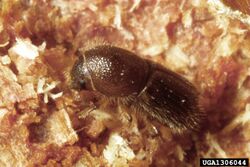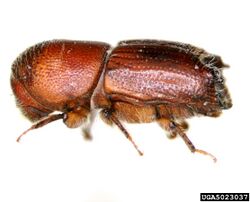Biology:Ips pini
| Ips pini | |
|---|---|

| |
| Scientific classification | |
| Domain: | Eukaryota |
| Kingdom: | Animalia |
| Phylum: | Arthropoda |
| Class: | Insecta |
| Order: | Coleoptera |
| Infraorder: | Cucujiformia |
| Family: | Curculionidae |
| Genus: | Ips |
| Species: | I. pini
|
| Binomial name | |
| Ips pini (Say)
| |
Ips pini, known generally as the pine engraver or North American pine engraver, is a species of typical bark beetle in the family Curculionidae.[1][2][3] Males construct nuptial chambers in the bark of dead pine or spruce trees. Ips pini is a tremendous pest when it comes to pines, but mostly of mature red pine plantations. When humans try to get rid of them by trying to burn their habitat, it makes them reproduce even more. As trees get wider, their population ends up competing with other species, but mostly because of the temperature and the chemicals used to stop them is helping the beetle even more. [4]
They are polygynous. After mating, the females create ovipositional chambers off of the nuptial chamber and lay eggs within the gallery. [5]
References
- ↑ "Ips pini Report". https://www.itis.gov/servlet/SingleRpt/SingleRpt?search_topic=TSN&search_value=114941.
- ↑ "Ips pini". https://www.gbif.org/species/9273685.
- ↑ "Ips pini species Information". https://bugguide.net/node/view/360714.
- ↑ 1. Gaylord, M. L., McKelvey, S. R., Fettig, C. J., & McMillin, J. D. (2020). Verbenone Inhibits Attraction of Ips pini (Coleoptera: Curculionidae) to Pheromone-Baited Traps in Northern Arizona. Journal of Economic Entomology, 113(6), 3017–3020. https://doi.org/10.1093/jee/toaa192 / 2. Hayes, C. J., DeGomez, T. E., McMillin, J. D., Anhold, J. A., & Hofstetter, R. W. (2008). Factors influencing pine engraver ( Ips pini Say) colonization of ponderosa pine ( Pinus ponderosa Dougl. ex. Laws.) slash in Northern Arizona. Forest Ecology and Management, 255(8), 3541–3548. https://doi.org/10.1016/j.foreco.2008.02.037 / 3. Kopper, B. J., Klepzig, K. D., & Raffa, K. F. (2004). Components of Antagonism and Mutualism in Ips pini–Fungal Interactions: Relationship to a Life History of Colonizing Highly Stressed and Dead Trees. Environmental Entomology, 33(1), 28–34. https://doi.org/10.1603/0046-225X-33.1.28
- ↑ Aukema, Brian H.; Richards, Greg R.; Krauth, Steven J.; Raffa, Kenneth F. (1 January 2004). "Species Assemblage Arriving at and Emerging from Trees Colonized by Ips pini in the Great Lakes Region: Partitioning by Time Since Colonization, Season, and Host Species". Annals of the Entomological Society of America 97 (1): 117–129. doi:10.1603/0013-8746(2004)097[0117:SAAAAE2.0.CO;2].
Further reading
- Catalogue of Palaearctic Coleoptera, Volume 7: Curculionoidea I. Apollo Books. 2013. ISBN 978-90-04-26093-1.
- Catalogue of Palaearctic Coleoptera, Volume 8: Curculionoidea II. Apollo Books. 2013. ISBN 978-90-04-25916-4.
External links
Wikidata ☰ Q24956106 entry
 |


